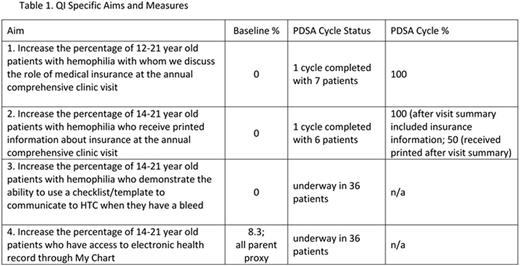Abstract
Introduction
Persons with hemophilia require complex medical care by a multi-disciplinary team throughout life. There are opportunities for Hemophilia Treatment Centers (HTC) to enhance the care of persons with hemophilia through participation in quality improvement (QI) initiatives. Maintaining comprehensive care and excellent health outcomes are national priorities for Health Resources and Services Administration (HRSA) and the American Thrombosis and Hemostasis Network (ATHN), the National Hemophilia Program Coordinating Center (NHPCC). Rady Children's Hospital San Diego (RCHSD) HTC participated in the NHPCC Dartmouth Improvement Program pilot program with the aim to develop QI capabilities within the HTCs to enhance the care of persons with hemophilia.
Methods
RCHSD participated in the NHPCC Dartmouth Improvement Program starting in December 2015. A QI team was established including the HTC medical director, nurse case managers, pediatric social worker and the social worker of the collaborating adult HTC. The QI team was coached by an expert TDIMA coach and a "coach in training" from another HTC. The team learned QI methods through in person training, web-based training and weekly team meetings with the coaches. The team assessed HTC data (The 5Ps-purpose, patients, professionals, processes, and patterns) to gain system knowledge and insights to determine a QI theme, global aim, specific aims and associated PDSA cycles.
Results
The RCHSD HTC QI team established a QI theme to focus on the transfer from pediatric to adult care. The Global Aim of the team is to improve autonomous communication in RCHSD HTC. The process begins with the 12 year old comprehensive clinic visit and ends with a new patient visit at an adult HTC. By working on the process, we expect patients to have the communication skills to be able to arrange medical insurance, call the home care company to order factor and to communicate their health and personal care needs to adult health care providers. We developed four specific aims which are in various stages of testing in PDSA cycles (Table 1). For Aim 1, we found that patients have only basic knowledge of insurance information. For Aim 2, we found that we needed to adjust our clinic process to make sure that patients receive their "after visit summary" that includes the insurance information prior to leaving clinic.
Conclusions
We developed a QI program within RCHSD HTC focused on improving transfer of care. Once we have completed the specific aim PDSA cycles we will standardize the new and improved procedures. We will continue to develop the program based on internal needs assessment and family input. This training model may be adapted by other HTCs to enhance patient care.
Thornburg:Mast Pharmaceuticals: Research Funding; Bayer Pharmaceuticals: Research Funding; Shire: Consultancy; Biogen Idec: Other: Data Safety Monitoring Board; Bluebird inc: Other: Data Safety Monitoring Board.
Author notes
Asterisk with author names denotes non-ASH members.


This feature is available to Subscribers Only
Sign In or Create an Account Close Modal